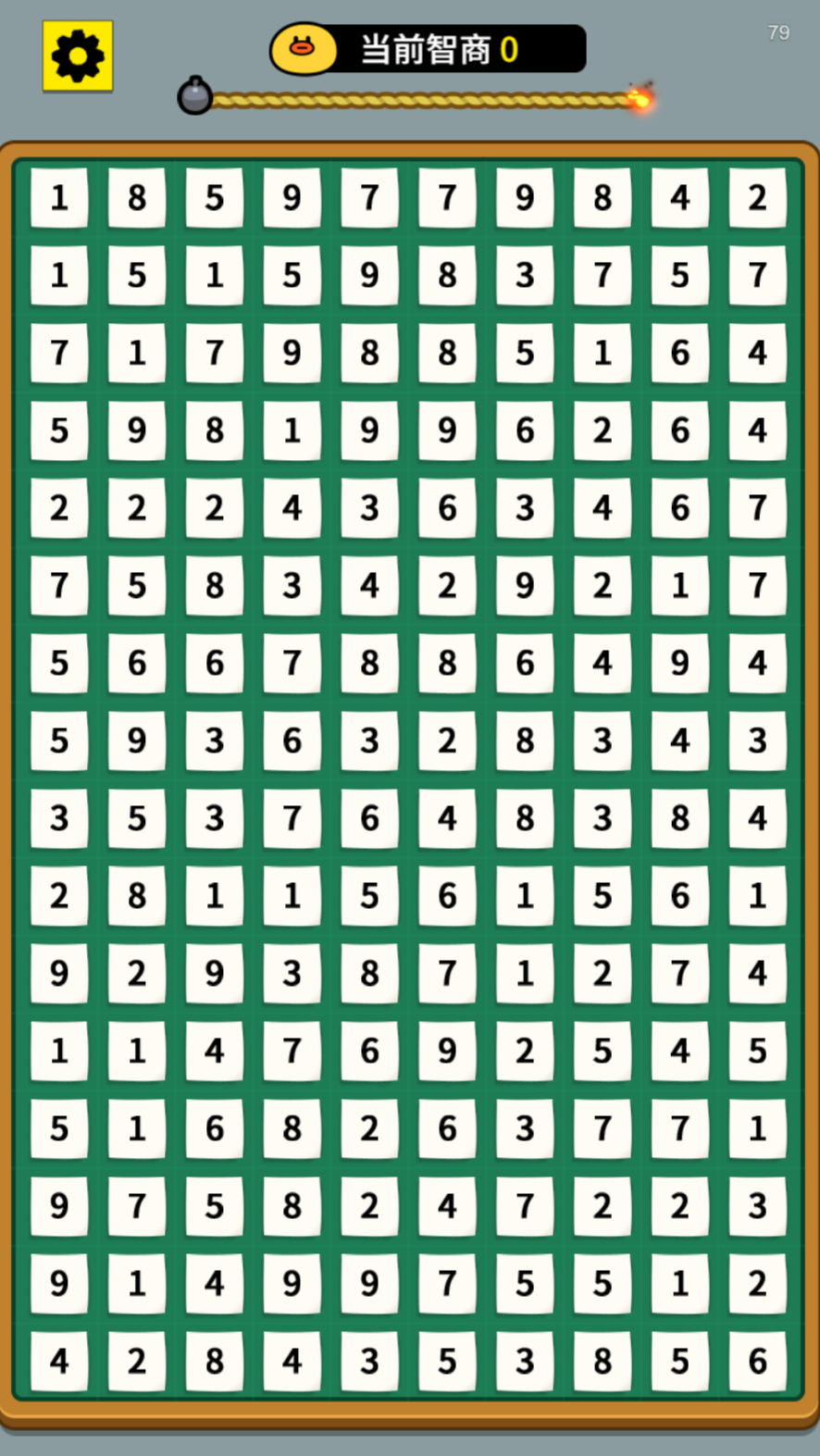1
2
3
4
5
6
7
8
9
10
11
12
13
14
15
16
17
18
19
20
21
22
23
24
25
26
27
28
29
30
31
32
33
34
35
36
37
38
39
40
41
42
43
44
45
46
47
48
49
50
51
52
53
54
55
56
57
58
59
60
61
62
63
64
65
66
67
68
69
70
71
72
73
74
75
76
77
78
79
80
81
82
83
84
85
86
87
88
89
90
91
92
93
94
95
96
97
98
99
100
101
102
103
104
105
106
107
108
109
110
111
112
113
114
115
116
117
118
119
120
121
122
123
124
125
126
127
128
129
130
131
132
133
134
135
136
137
138
139
140
141
142
143
144
145
146
147
148
149
150
151
152
153
154
155
156
157
158
159
160
161
162
163
164
165
166
167
168
169
170
171
| def cal_all_x(self, End=False, action=False):
if End:
return
else:
End=True
for x_len in range(1, 16):
for y_len in range(1, 10):
for begin_x in range(0, 16-x_len+1):
for begin_y in range(0, 10-y_len+1):
_sum = np.sum(self.cal_matrix[begin_x:begin_x+x_len,begin_y: begin_y + y_len])
if _sum == 10:
self.cal_matrix[begin_x:begin_x+x_len,begin_y: begin_y + y_len] = 0
if action:
self.action(begin_x, begin_x+x_len, begin_y, begin_y + y_len)
End = False
self.cal_all_x(End=End, action=action)
def cal_all_y(self, End=False, action=False):
if End:
return
else:
End=True
for y_len in range(1, 10):
for x_len in range(1, 16):
for begin_x in range(0, 16-x_len+1):
for begin_y in range(0, 10-y_len+1):
_sum = np.sum(self.cal_matrix[begin_x:begin_x+x_len,begin_y: begin_y + y_len])
if _sum == 10:
self.cal_matrix[begin_x:begin_x+x_len,begin_y: begin_y + y_len] = 0
if action:
self.action(begin_x, begin_x+x_len, begin_y, begin_y + y_len)
End = False
self.cal_all_y(End=End, action=action)
def cal_two_x(self, End=False, action=False):
if End:
return
else:
End=True
for begin_x in range(0, 16):
for begin_y in range(0, 10):
# 搜索右边
if self.cal_matrix[begin_x, begin_y] ==0:
continue
if len(self.s1list) >0 and self.cal_matrix[begin_x, begin_y] not in self.s1list:
continue
for x in range(begin_x+1, 16):
if self.cal_matrix[x, begin_y] ==0:
continue
elif self.cal_matrix[begin_x, begin_y]+self.cal_matrix[x, begin_y] ==10:
self.cal_matrix[x, begin_y] = 0
self.cal_matrix[begin_x, begin_y] = 0
if action:
self.action(begin_x, x+1, begin_y, begin_y+1)
End = False
break
else:
break
# 搜索左边
for x in range(begin_x-1, -1, -1):
if x < 0:
break
if self.cal_matrix[x, begin_y] ==0:
continue
elif self.cal_matrix[begin_x, begin_y]+self.cal_matrix[x, begin_y] ==10:
self.cal_matrix[x, begin_y] = 0
self.cal_matrix[begin_x, begin_y] = 0
if action:
self.action(x, begin_x+1, begin_y, begin_y+1)
End = False
break
else:
break
# 搜索下面
for y in range(begin_y+1, 10):
if self.cal_matrix[begin_x, y] ==0:
continue
elif self.cal_matrix[begin_x, begin_y]+self.cal_matrix[begin_x, y] ==10:
self.cal_matrix[begin_x, begin_y] = 0
self.cal_matrix[begin_x, y] = 0
if action:
self.action(begin_x, begin_x+1, begin_y, y+1)
End = False
break
else:
break
# 搜索上面
for y in range(begin_y-1, -1, -1):
if y < 0:
break
if self.cal_matrix[begin_x, y] ==0:
continue
elif self.cal_matrix[begin_x, begin_y]+self.cal_matrix[begin_x, y] ==10:
self.cal_matrix[begin_x, begin_y] = 0
self.cal_matrix[begin_x, y] = 0
if action:
self.action(begin_x, begin_x+1, y, begin_y+1)
End = False
break
else:
break
self.cal_two_x(End=End, action=action)
def cal_two_y(self, End=False, action=False):
if End:
return
else:
End=True
for begin_y in range(0, 10):
for begin_x in range(0, 16):
# 搜索右边
if self.cal_matrix[begin_x, begin_y] ==0:
continue
if len(self.s1list) >0 and self.cal_matrix[begin_x, begin_y] not in self.s1list:
continue
for x in range(begin_x+1, 16):
if self.cal_matrix[x, begin_y] ==0:
continue
elif self.cal_matrix[begin_x, begin_y]+self.cal_matrix[x, begin_y] ==10:
self.cal_matrix[x, begin_y] = 0
self.cal_matrix[begin_x, begin_y] = 0
if action:
self.action(begin_x, x+1, begin_y, begin_y+1)
End = False
break
else:
break
# 搜索左边
for x in range(begin_x-1, -1, -1):
if x < 0:
break
if self.cal_matrix[x, begin_y] ==0:
continue
elif self.cal_matrix[begin_x, begin_y]+self.cal_matrix[x, begin_y] ==10:
self.cal_matrix[x, begin_y] = 0
self.cal_matrix[begin_x, begin_y] = 0
if action:
self.action(x, begin_x+1, begin_y, begin_y+1)
End = False
break
else:
break
# 搜索下面
for y in range(begin_y+1, 10):
if self.cal_matrix[begin_x, y] ==0:
continue
elif self.cal_matrix[begin_x, begin_y]+self.cal_matrix[begin_x, y] ==10:
self.cal_matrix[begin_x, begin_y] = 0
self.cal_matrix[begin_x, y] = 0
if action:
self.action(begin_x, begin_x+1, begin_y, y+1)
End = False
break
else:
break
# 搜索上面
for y in range(begin_y-1, -1, -1):
if y < 0:
break
if self.cal_matrix[begin_x, y] ==0:
continue
elif self.cal_matrix[begin_x, begin_y]+self.cal_matrix[begin_x, y] ==10:
self.cal_matrix[begin_x, begin_y] = 0
self.cal_matrix[begin_x, y] = 0
if action:
self.action(begin_x, begin_x+1, y, begin_y+1)
End = False
break
else:
break
self.cal_two_y(End=End, action=action)
|






